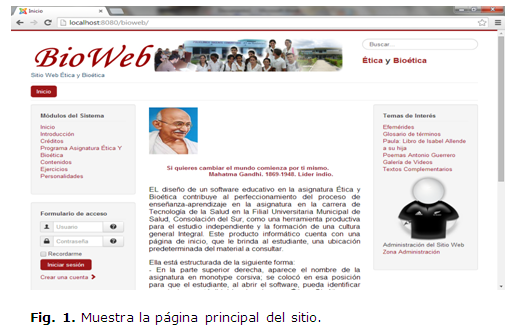Educative software in the teaching-learning process of the subject Ethics and Bioethics
Keywords:
Software, Audiovisual aids/utilization, Teaching.Abstract
Introduction: the teaching of ethics and bioethics is a latent need, a non-solved problem for higher education in all institutions and majors in current times, since the personnel graduated from medical universities requires treating from the ethic perception the scope of professional activity in the health area where he or she will make career, and thus to provide an approach to the principals, standards and values of the health care services in the context of the Cuban socialist project.Objective: to design a teaching aid that contributes with the teaching-learning process in the subject Ethics and Bioethics in the major Bachelor in Health Technology of the Consolación del Sur Municipal University Health Venue.
Material and method: the present study was based on a technologic innovation project in the undergraduate section, from a comprehensive research approach, having a methodological basis the dialectical materialistic method. Theoretical, empirical, and statistical methods were used; within the first ones, the logical-historical, systemic-structural and the bibliographic review; within the second ones, surveys, interviews and observation.
Results: there is lack of teaching aids supported by the educative technology satisfying accessibility in the assimilation of contents and motivation for learning thus contributing to perfecting the subject Ethics and Bioethics, insufficient understanding by the students of the importance of the subject for their professional performance, low levels of acquisition of skill by the students, and elements affecting the quality of the teaching learning process of this subject.
Conclusions: a educative software was designed for studying the subject Ethics and Bioethics, which will permit the student an active, conscious and developing learning, facilitating the acquisition of skills and knowledge for professional performance. Consultation to the experts confirmed the validity of the educative software for the subject Ethics and Bioethics of the major Bachelor of Health Technology, and viability of its implementation in Consolación del Sur Municipal University Health Venue.
Downloads
References
1. Pernas Gómez M, Sierra Figueredo S, Fernández Sacasas JA, Miralles Aguilera E, Diego Cobelo JM. Principios estratégicos de la educación en Ciencias de la salud en Cuba (II): la pertinencia. Educ Med Super[Internet]. 2009 Jun. [citado 2014 mar 02]; 23(2). Disponible en: http://scielo.sld.cu/scielo.php?script=sci_arttext&pid=S0864-21412009000200006
2. Vidal Ledo M, Pernas Gómez M. Diseño curricular. Educ Med Super[en internet]. 2007[citado mayo 2013]; 21(2): Disponible en: http://scielo.sld.cu/scielo.php?pid=S0864-21412007000200012&script=sci_arttext
3. Pernas Gómez M, Arencibia Flores L, Ortiz García L. El plan de estudio para la formación del médico general básico en Cuba: Experiencias de su aplicación. Educ Med Super[en internet]. 2001[citado mayo 2013]; 15(1): 9-21. Disponible en: http://www.bvs.sld.cu/revistas/ems/vol15_1_01/ems02101.htm
4. Salas Perea RS. La calidad en el desarrollo profesional: avances y desafíos. Educ Med Super[Internet]. 2000 Ago[citado 2014 mar 02]; 14(2): [Aprox. 11p.]. Disponible en: http://scielo.sld.cu/scielo.php?script=sci_arttext&pid=S0864-21412000000200003&lng=es
5. Hodelín Tablada R. La enseñanza de la bioética en el pregrado. Reflexiones sobre un problema inconcluso. Rev haban cienc med[Internet]. 2007[citado 12 dic 2013]; 6(5): 1-5.Disponible en: http://www.bvs.sld.cu/revistas/rhab/rhcm_vol_6num_5/rhcm08507.htm
6. Vidal Ledo M, del Pozo Cruz CR. Medios de enseñanza. Educ Med Super[Internet]. 2006 Mar[citado 2013 feb 01]; 20(1). Disponible en: http://scielo.sld.cu/scielo.php?script=sci_arttext&pid=S0864-21412006000100009&lng=es
7. Escudero JM. Tecnología Educativa: algunas reflexiones desde la perspectiva de la innovación y la mejora de la educación. En: Alonso Cano C. La Tecnología Educativa a fines del siglo XX: concepciones, conexiones y límites con otras disciplinas. Barcelona: Universidad de Barcelona; III Jornadas Universitarias de Tecnología Educativa, 1997: 2-6.
8. Martín Díaz V, Romero López MA. La formación docente universitaria a través de las TICs. Revista de Medios y Educación [revista en internet]. Julio, 2009[citado enero 2014]; 35:97-103. Disponible en: http://www.redalyc.org/articulo.oa?id=36812381008
9. Vidal Ledo M, Cañizares Luna O, Sarasa Muñoz N, Santana Machado A. Las nuevas tecnologías de la enseñanza y el aprendizaje de la Anatomía Humana. Educ Med Super[revista en la internet]. 2004 Dic[citado Feb 2014]; 18(4): 1-1. Disponible en: http://scielo.sld.cu/scielo.php?script=sci_arttext&pid=S0864-21412004000400010&lng=es
10. Morejón Labrada S. El Software Educativo un medio de enseñanza eficiente. Cuadernos de Educación y Desarrollo. [Internet]. Julio 2011 [citado 2014 mar 02]; 3(29). Disponible en: http://www.eumed.net/rev/ced/29/sml.htm

Published
How to Cite
Issue
Section
License
Authors who have publications with this journal agree to the following terms: Authors will retain their copyrights and grant the journal the right of first publication of their work, which will be publication of their work, which will be simultaneously subject to the Creative Commons Attribution License (CC-BY-NC 4.0) that allows third parties to share the work as long as its author and first publication in this journal are indicated.
Authors may adopt other non-exclusive license agreements for distribution of the published version of the work (e.g.: deposit it in an institutional telematic archive or publish it in a volume). Likewise, and according to the recommendations of the Medical Sciences Editorial (ECIMED), authors must declare in each article their contribution according to the CRediT taxonomy (contributor roles). This taxonomy includes 14 roles, which can be used to represent the tasks typically performed by contributors in scientific academic production. It should be consulted in monograph) whenever initial publication in this journal is indicated. Authors are allowed and encouraged to disseminate their work through the Internet (e.g., in institutional telematic archives or on their web page) before and during the submission process, which may produce interesting exchanges and increase citations of the published work. (See The effect of open access). https://casrai.org/credit/


